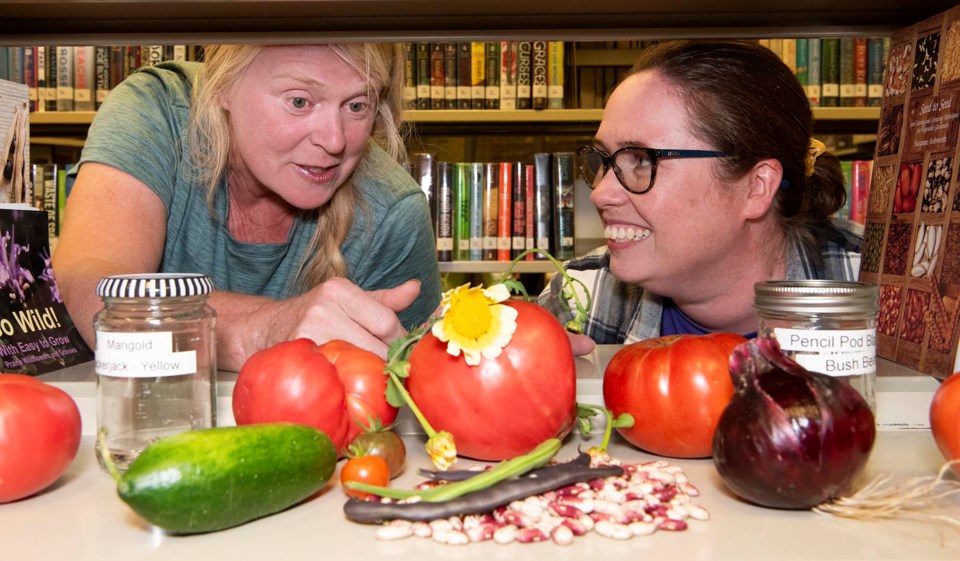Neighbours for climate
The Gazette is using the City of Edmonton’s Neighbouring for Climate guide to help St. Albert streets fight back against climate change. Check out the guide at edmonton.ca/climateneighbours.
Dale Ford’s neighbours must get a lot of vegetables.
The co-founder of the St. Albert Seed Library, Ford is a master gardener and has transformed her backyard into a field of plenty. There are giant tomatoes, rare melons and tomatillos, purple cauliflowers, beets of many colours, and all sorts of other fruits and vegetables, all raised from seeds adapted to St. Albert’s climate.
“I just donated about 10 pounds of tomatoes to the food bank,” she said, and her neighbours will likely get more free produce in the days ahead.
“I’ll give some tomatoes to my neighbour’s kids and they’ll eat them like apples!”
Global heating makes for wild weather, which threatens our food supply. As shoppers have likely noticed in recent years, droughts in California and fires in B.C. can cause shortages in stores and send prices skyrocketing. Fuel burned to haul in produce from abroad also releases heat-trapping pollution, making such agricultural disasters more likely.
Grow local
Planting gardens and sharing what you grow reduces food waste (and carbon pollution and packaging waste from it), cuts food costs, and supports your neighbours, Edmonton’s Neighbouring for Climate guide notes.
“It’s a great community-building exercise,” Ford said, noting she’s met and shared knowledge with newcomers from Ukraine, Africa, and Turkey through gardening.
“You’re kind of bonding over plants.”
Seed libraries or exchanges can make gardens more successful and improve local biodiversity, the climate guide notes.
St. Albert Public Library librarian Emily Brady worked with Ford to launch the St. Albert Seed Library in 2020. Located on the second floor of the downtown library, the Seed Library hosts 50 types of flowers, 27 vegetables, and 18 herbs, including some from the Dr. Anne Anderson Memorial Herb garden, alongside many books on gardening. The seeds are free, with some 2,949 packets distributed this year alone.
Seed library patrons “borrow” seeds in the spring to plant and grow and “return” seeds from those crops in the fall for next year, Brady and Ford explained. By saving the seeds from the best-performing plants, the library builds up a stock of seeds adapted to St. Albert’s changing climate and more resistant to global heating.
Anyone can check out seeds from the St. Albert Seed Library, but if you want to start your own, just share some seeds with your neighbours, Brady said. The St. Albert Backyard Gardening Facebook group can help you find seed-trading partners.
While she personally has enough seeds in her house for a small farm, Ford said a small seed library can fit in a cabinet. To stock it, start with seeds rated to grow in plant hardiness Zone 4 or lower in Alberta, ideally ones labelled “heirloom,” “open pollinated,” and “heritage.” Unlike hybrid varieties (which require complex breeding procedures), plants with these labels will produce consistent results year after year, and are often specifically adapted to Alberta’s climate. They may also have superior tastes or unusual traits not found in commercial crops.
Every plant requires a different technique when it comes to seed harvesting, Ford said — the Farmer’s Almanac website has many videos on the subject. In general, you wait until the seeds are ripe (for beans, that happens when the pods are dry), wash off and remove anything that’s not the seed, then let the seeds dry completely on a paper towel. Dried seeds should go in a paper envelope and be stored in a cool, dry place. Depending on the plant, those seeds should last anywhere from a year to several centuries.
Ford will host an online workshop on harvesting seeds Sept. 7 at 7 p.m. Visit sapl.libcal.com/event/3734890 to register.



